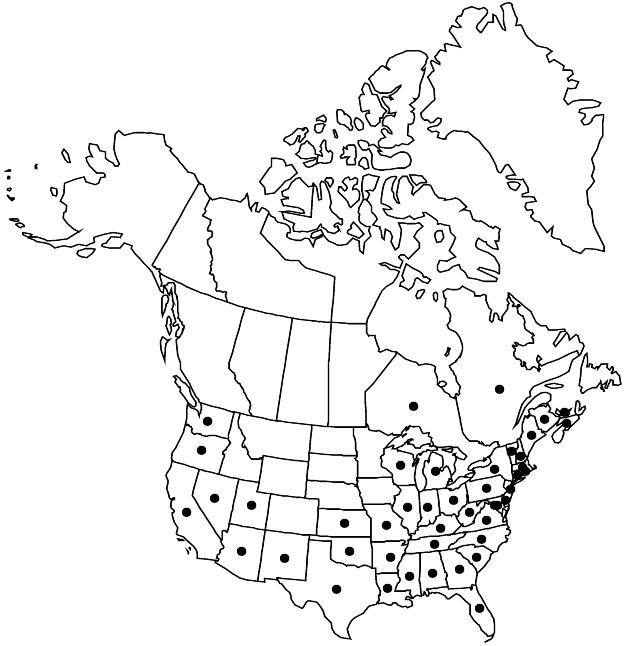Samolus parviflorus
Amer. Monthly Mag. & Crit. Rev. 2: 176. 1818,.
Plants light green, not stoloniferous, 0.7–8.2 dm. Stems erect or ascending (rarely prostrate). Leaves basal and cauline or all cauline, sessile or petiolate; blade obovate or broadly spatulate to elliptic, 1.5–15 cm, base decurrent, cuneate, apex rounded to obtuse. Inflorescences terminal or terminal and axillary, usually racemose, sometimes paniculate, sessile or pedunculate; peduncle to 0.7 cm, usually shorter (to longer) than stem. Pedicels spreading or ascending, bracteate, 1.5–14 mm, glabrous; bract at midlength. Flowers: calyx 1.3–1.5(–2) mm, lobes triangular to ovate, shorter than tube, apex acute, not glandular; corolla white, 1.2–3 mm, lobes oblong, longer than tube, base glabrous, apex rounded or emarginate; staminodes 5. Capsules 2–3 mm. 2n = 26.
Phenology: Flowering spring–fall.
Habitat: Wet places
Elevation: 0-1700 m
Distribution

N.B., N.S., Ont., P.E.I., Que., Ala., Ariz., Ark., Calif., Conn., Del., D.C., Fla., Ga., Ill., Ind., Kans., Ky., La., Maine, Md., Mass., Mich., Miss., Mo., Nev., N.H., N.J., N.Mex., N.Y., N.C., Ohio, Okla., Oreg., Pa., R.I., S.C., Tenn., Tex., Utah, Vt., Va., Wash., W.Va., Wis., Mexico, West Indies, Central America (Honduras), South America (Bolivia), e Asia (Japan).
Discussion
Confirmed Canadian populations of Samolus parviflorus appear to be limited to the Atlantic coastal areas and the Ottawa region of the Saint Lawrence Seaway, with a historical record (1903) known from southern Saskatchewan. A report from British Columbia (www.natureserve.org, 2006) is erroneous; no specimens exist at DAO or UBC as reported.
The name Samolus floribundus has sometimes been applied to this taxon. The publication date for S. floribundus is February 1818, making it later than S. parviflorus, published in January of that same year. Some taxonomists include this species within the European S. valerandi; that species has larger flowers and capsules, fewer racemes, and staminodes occurring in clusters of one to three. No specimens have been found of true European S. valerandi in the flora area; previous specimens labeled as S. valerandi are native species, usually S. parviflorus.
Samolus parviflorus is occasionally sold as an aquarium plant (“underwater salad”).
Selected References
None.
